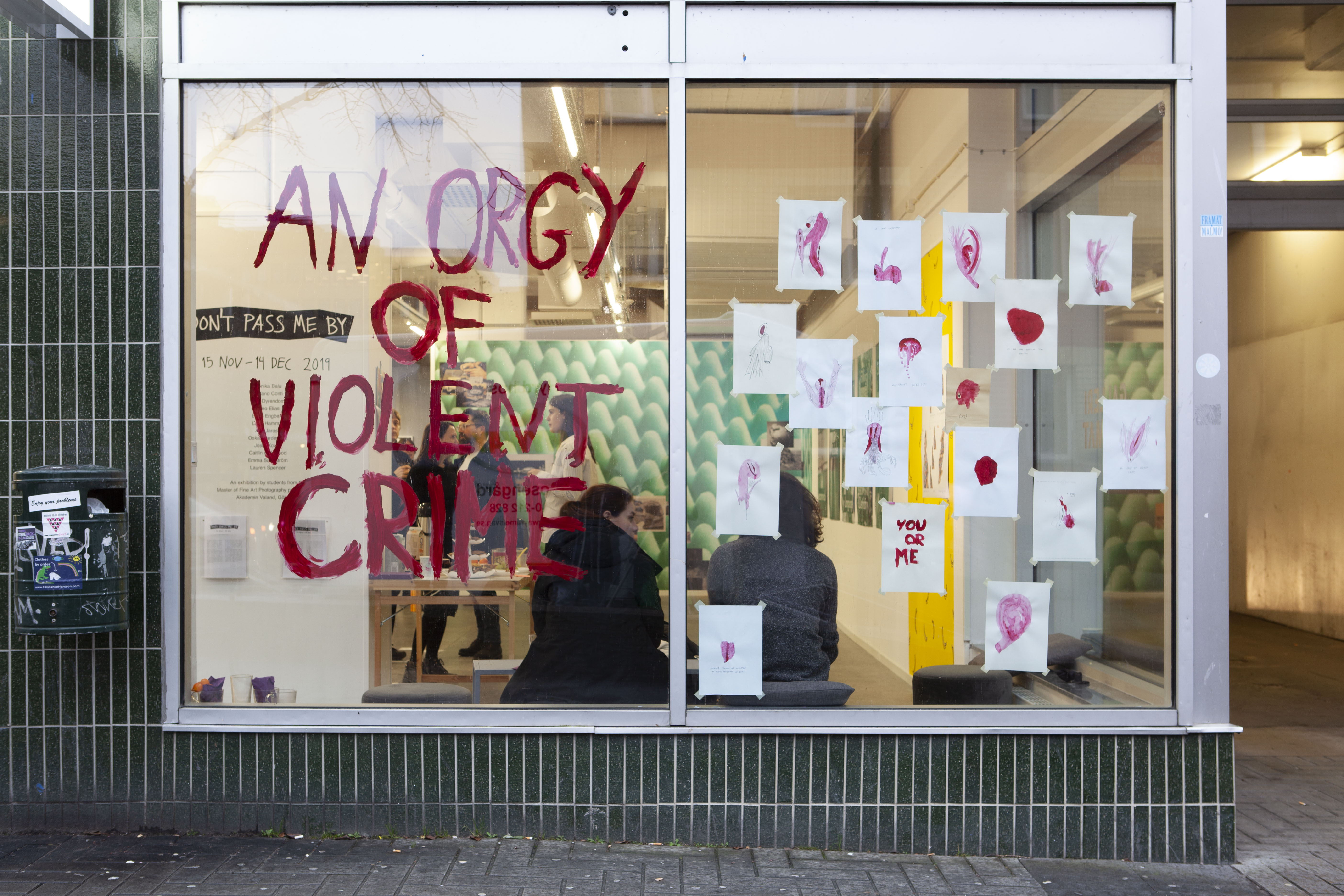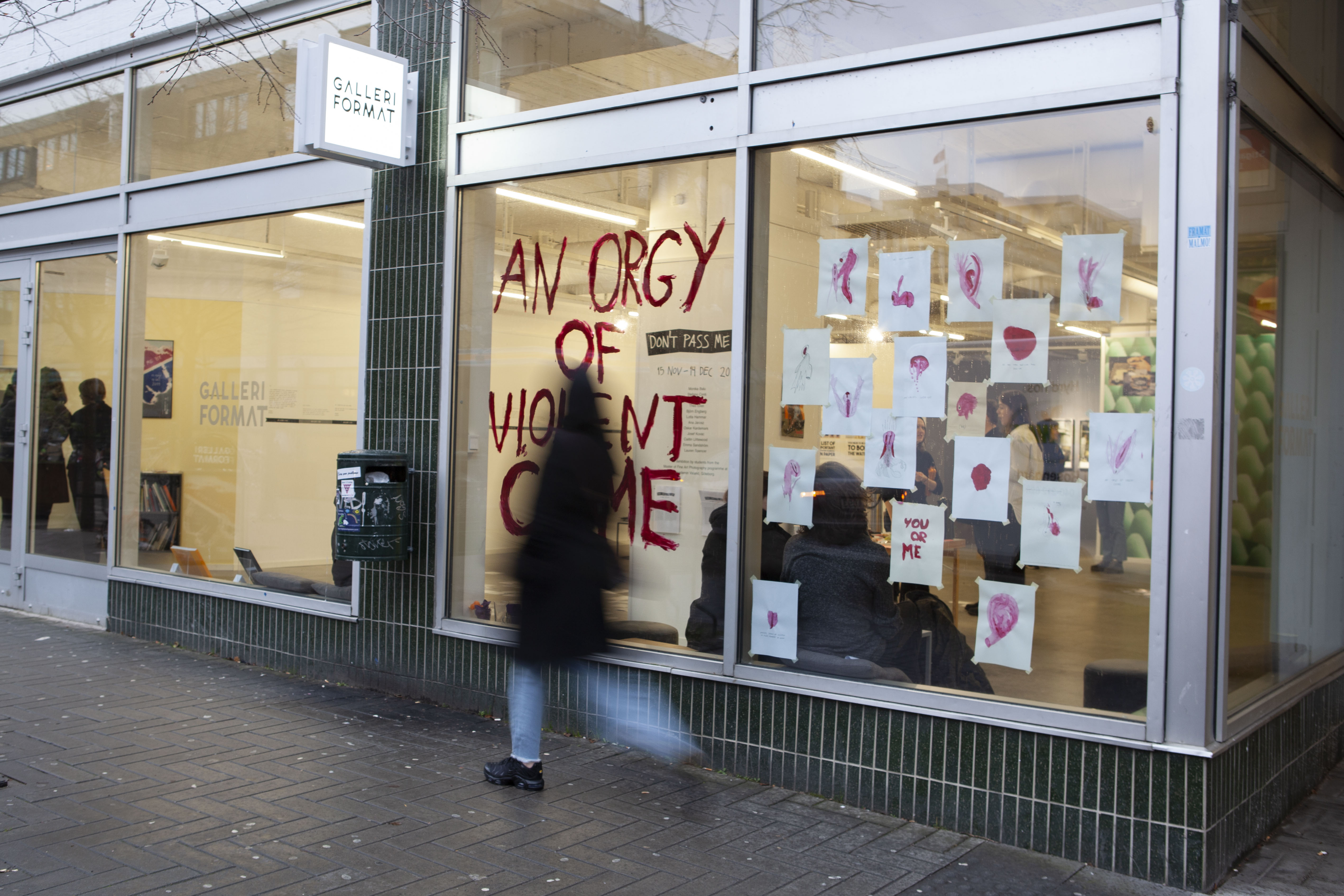



An Orgy Of Violent Crime
2019
acrylic on glass and paper
as part of
Don’t Pass Me By
Galleri Format, Malmö
Communication, information and propaganda; the poster as phenomenon is closely linked to industrialism with its incalculable and devastating effects on the world as we know it. Regardless, the 20th century provided us with a firework of fine art, music, politics and drama which shaped and challenged us to the core. The poster with all its abilities and possibilities has played a huge role in communication along the way. In the exhibition Don´t Pass Me By, twelve students from the Masters Programme in Photography at Akademin Valand have looked at the poster format from a conceptual and material point of view. The long-standing tradition of this particular and sometimes ephemeral way of communication has been re-visited in this experimental project. What relevance does this space of expression have in the digital society today?
Lauren Spencer has literally taken to the streets in order to collect the leftovers of posters torn down from their pillars. Spencer has re-photographed small remnants of paper with little or no information left and in a semi-archeological fashion she is presenting these fragments in poster size. The images of dismissible objects exudes beauty and fragility in a way that only the magic of photographic enlargement can produce together with the will and desire of the artist. An abstraction of the culture of information called Poor Pictures. Another series of posters stemming from the streets is the work of Theo Elias called Missing. For years he has photographed the collective habit of putting up notifications of missing persons or pets in the public sphere. In an anthropological gesture, the posters from different cities around the world have been collected and transferred into the gallery space. The result is a moving series of images depicting despair and mirroring the vulnerability in our society. The fate of the missing persons or pets is unknown, still celebrated and memorialized in front of us.
In a combination of informative posters and visual art à la Barbara Krüger, the work Vipeholm Revisited by Caitlin Littlewood deals with a Swedish trauma known as "The Vipeholm Experiments" where dental experimentation was performed by medical authorities on mentally challenged patients in the 40s and 50s. With a sinister humour, Littlewood recalls this dark era in Swedish medicine and pays tribute to the victims of this deeply problematic event. In a meta-visual comment, Littlewood has also made a poster using iconic and cinematic rhetoric where she personates Saint Appollonia - the patron of dentistry. As Littlewood draws inspiration from society and trauma, Lars Dyrendom works from a Danish perspective when scrutinizing the impact colonialism has had on Greenland. Colonialism with its cynical violence towards indigenous people and their culture is ever present in the contemporary world. Putting the poster work (Colonial) Delineations #250 literally on the floor, Dyrendom works with archival material consisting of aerial mapping of Greenlandic soil made by the Danish government in the 80s for commercial reasons. It is no coincidence that Greenland with its strategic placement and rich natural resources has recently been the target of interest from Donald Trump, the most prominent embodiment of exploitation today.
Oskar Kardemark returns to his personal archive when presenting, in a cinematic manner, the story of his grandfather in the triptych Born into this. In an uncanny snap shot from a dilapidated house the grandfather revisits his childhood home only to find it in ruins. The snap shot is divided in three images cropped into a classical movie poster format, and the frames and wall are painted in a silvery colour, indicating that anybody’s life has the potential to turn into fiction. Kardemark reminds us that we live in a mutual world of untold stories. A different approach to the archive is the work of Emma Sandström who usually collects objects and images and composes them in three dimensional installations. For the poster exhibition Sandström has re-worked a former installation into a wall-based explosion of visual information called Untitled Vol. 4-5 (flat). The poster format is here excessively expanded and installed in layers to create an associative drama on the wall and the cause and effect of objects and events are here suspended with joy.
The Swedish Civil Contingencies Agency (MSB) and the brochure "If Crisis or War Comes" distributed to all households in Sweden in 2018 has been an interest of Lotta Hammar in the poster project called Important Public Announcement.
Hammar has collected and photographed a series of objects found at home: soft toys, potted flowers, books on Bruce Springsteen and more. The matter-of-fact images are combined with text fragments drawn from the brochure. With dark humour and concern, Hammar makes us realize that the objects at hand won't help much in a situation of crisis. Should we prepare? Also appropriating the language of informational printed matters but on a more personal level, and with a subject crucial to us all, the work of Monika Balu is oriented towards hearing impairment, communication and sound. Balu is using the self-portrait as a means of speaking to the audience on how to address her properly. The accompanying text has lost many of its letters in order to mimic the frequency where sound and thus meaning goes missing in a hearing-impaired reality. The execution of the piece Auditory Communication is both dry, humorous and thought provoking, reminding us that our senses are fraudulent.
In a dark imaginary reality, Josef Kovac tells a strange tale without words, yet with the narrative title: It was the middle of the night somewhere in Central Europe at the end of December 1991. Through powerful visual language we are invited to make associations around power, dreams and alienation. There are connections to the tradition of "the absurd" and also to the surrealist movement - currents that grew strong in western society in an era of great political turmoil, not unlike the situation in Europe today. This situation can also be seen expressed in the painting by Anna Jarosz who in a gesture of rage has written "An Orgy of Violent Crime" on the storefront window of Galleri Format. Jarosz is sidestepping the materiality of the paper to emphasize the message. The vulnerability stated in the words is reproduced in the smaller drawings also attached the glass window; abstract shapes reminiscent of body parts or fluids that reflects a desire to formulate pain.
The deceitful nature of internet culture is explored by Stefano Conti who has collected screen shots from CCTV cameras that, due to a lack of "password-awareness", have been streamed into the ether. The posters created from the visual material that Conti has collected are available to the public for free. I Wish I Could Tell You is both a humorous and disturbing work of art, addressing questions about integrity, digital vulnerability and surveillance. It both embraces and challenges the voyeurism latent in all of us. And in a way this voyeurism or curiosity is also being satisfied in the trip report by Björn Engström who has made a serene piece about a ritual of sorts where he consumed a hallucinogenic mushroom. A still image where Engström is laying on the ground is projected onto a hovering handmade paper. The image is accompanied by the voice of the artist speaking about his encounter with the drug. The paper is made out of the fibers from hallucinogenic mushrooms and in this piece by Engström called Amanita Power Nap, the entire poster culture of the 60s can be said to converge.
Being used for political, commercial, fine art and purely informational reasons, the poster format has never stopped being an active and thrilling space to conquer. In order to emphasize the easy-to-handle qualities of the poster and to act upon the current situation of climate change, the entire exhibition is transported from Göteborg to Malmö as carry-on-luggage on the train.
Annika von Hausswolff, November 2019